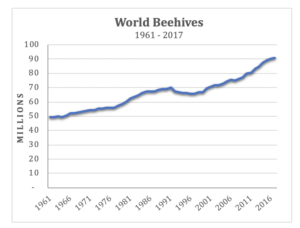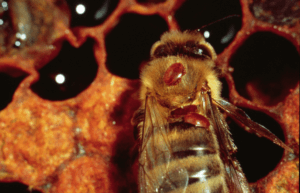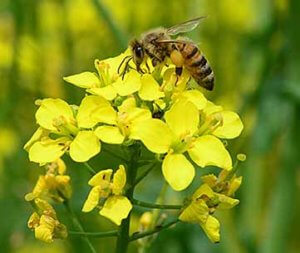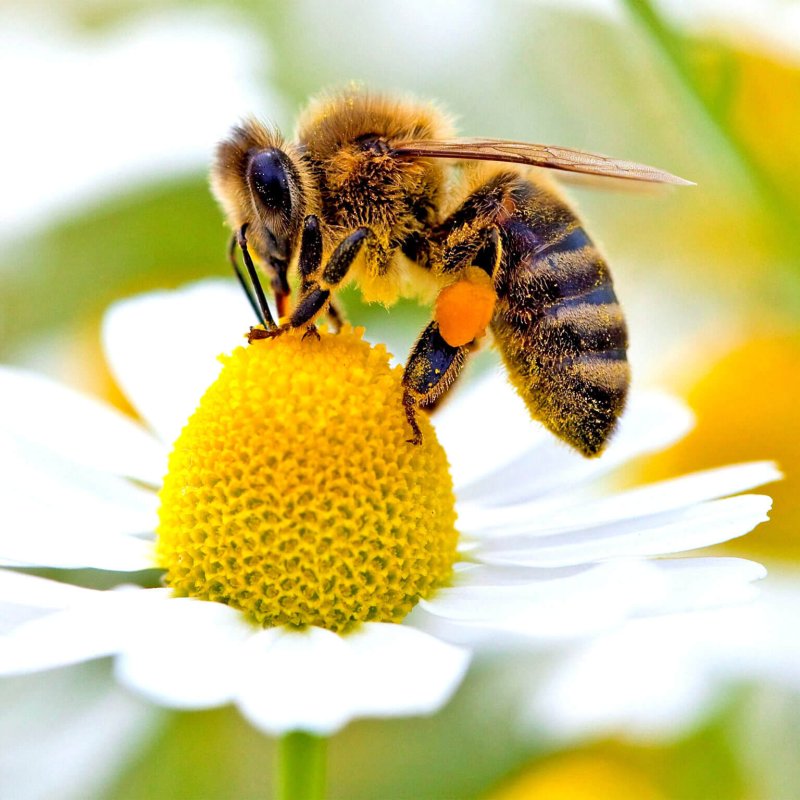What is sulfoxaflor? We’ll address some of the science later in this piece, but suffice to say for now that it is a less commonly used insecticide that serves as a kind of insurance policy for farmers when other chemicals don’t work so well. Sulfoxaflor is firmly entrenched in the highly-politicized ‘bee wars’—the attempt by many environmental groups  to blame the health problems of honeybees and wild bees on synthetic pesticides. The Genetic Literacy Project has reported extensively on the so-called “Bee-pocalypse” that’s so prominent in environmental reporting. Since 2012-2013, we’ve been treated to almost non-stop scaremongering about declining bee populations (even as the global population of honeybees has reached an all-time high) with an almost monomaniacal focus on pesticides, particularly a class of newer generation insecticides known as neonicotinoids, blamed as the driving source of the problem
to blame the health problems of honeybees and wild bees on synthetic pesticides. The Genetic Literacy Project has reported extensively on the so-called “Bee-pocalypse” that’s so prominent in environmental reporting. Since 2012-2013, we’ve been treated to almost non-stop scaremongering about declining bee populations (even as the global population of honeybees has reached an all-time high) with an almost monomaniacal focus on pesticides, particularly a class of newer generation insecticides known as neonicotinoids, blamed as the driving source of the problem
Mainstream entomologists are generally agreed that all agricultural chemicals, organic and synthetic, play a role in bee health issues but their comparative impact is considered minor compared to other challenges. For over three decades, professional beekeepers and the entomologists and extension scientists who support them have known that the number one problem facing bees has been the Varroa mite–a parasitic mite, first introduced to the U.S. from the Far East around 1987. The Varroa infestation cut bee population in the US by almost one third over the following decade, and hurt colony numbers around the world, before honeybee numbers stabilized in the mid-1990s. That’s when neonics were introduced.
known that the number one problem facing bees has been the Varroa mite–a parasitic mite, first introduced to the U.S. from the Far East around 1987. The Varroa infestation cut bee population in the US by almost one third over the following decade, and hurt colony numbers around the world, before honeybee numbers stabilized in the mid-1990s. That’s when neonics were introduced.
Since then, the total number of honeybees has been steadily increasing in North America and Europe, although Varroa mites, the over-use of miticides and the frenetic transport of honeybees in cross-country agriculture have compromised bee health, requiring the splitting of hives to maintain high colony numbers.
Sloppy reporting around the bee health controversy was on display yet again in late May when many news outlets published stories proclaiming that a lawsuit brought by anti-pesticide groups had ‘forced’ the EPA to pull dozens of neonicotinoid insecticides off the market because of the threat they pose to bees. As the GLP reported, these stories from Bloomberg, NPR and many other outlets were incomplete at best and dishonest at worst, essentially rehashing press releases from the activist groups that brought the litigation. The EPA responded to the GLP, telling us it had banned none of these pesticides, all the withdrawals were voluntary and most critically it reinforced its prior position that there was no evidence that the insecticides in question pose a threat to bees.
Sloppy bee reporting redux
Unfortunately, the same substandard science reporting has made an appearance in July, following the EPA’s sulfoxaflor decision. Citing the activist group Beyond Pesticides (not known for its balanced analysis of complex scientific issues), The Guardian reported that sulfoxaflor’s expanded registration is “another example of the corruption for which [the Trump] administration is infamous.”
The Washington Post likewise reported, EPA to allow use of pesticide considered ‘very highly toxic’ to bees. Bloomberg claimed, EPA Eliminates Some Restrictions on Bee-Killing Pesticide. US News & World Report announced that the EPA Approves Pesticide Harmful to Bees. The Associated Press story, which was reprinted by the Los Angeles Times, San Francisco Chronicle and New York Times warned, EPA lets farmers resume broadly using pesticide that can hurt bees.
Some news organizations abandoned any hint of qualification or scientific objectivity, mimicking the propaganda issued by anti-chemical activist groups. EPA approves and expands previously-banned bee-harming pesticide, the Pesticide Action Network headlined a story on its home page. As if channeling PAN’s press release, Quartz opined in its headline: Pesticide harmful to bees allowed by EPA, again.
Running through all these activist headlines and articles was an assumption (and sometimes an outright assertion) that the Trump Administration (as problematic as it is on many science issues, including climate change) was now pulling the strings at the EPA, forcing career scientists to issue industry-friendly clearances when the evidence collected over multiple administrations suggests otherwise. The media framed the story as a battle between pro-science environmental groups and a duplicitous federal agency now in league with the chemical companies it regulates.
Background on sulfoxaflor
Let’s move from politics to science and the law.
The EPA registered sulfoxaflor for certain emergency uses in 2012 and broad agricultural use in 2013. The new insecticide attacks the central nervous system of insects through a unique mode of action, and was designed as an alternative to a class of pesticides called organophosphates, which are highly toxic to animals and humans, and which were mostly phased out when neonicotinoids, considered far safer, were introduced in the 1990s. Sulfoxaflor requires far fewer applications to control pests than its predecessors, and studies have shown that it combats troublesome insects that carbamate, neonicotinoid, organophosphate and pyrethroid insecticides cannot always keep in check.
Not everyone was thrilled about this development, however. In 2013, a coalition of mostly smaller hobby beekeepers and activist groups sued the EPA to block the registration of sulfoxaflor. The anti-GMO legal nonprofit EarthJustice, which represented the plaintiffs, warned:
Our country is facing widespread bee colony collapse, and scientists are pointing to pesticides like Sulfoxaflar as the cause. The effects will be devastating to our nation’s food supply and also to the beekeeping industry, which is struggling because of toxic pesticides.
 In September 2015, a federal appeals court struck down the registration, claiming that the EPA’s approval “was based on flawed and limited data.” The court ordered the agency to collect more evidence to determine how sulfoxaflor could impact pollinators. In October 2016, the EPA issued a new, more limited registration for sulfoxaflor use “… only on crops that are not attractive to pollinators or for crop production scenarios that minimize or eliminate potential exposure to bees,” which the agency said complied with the court’s requirements. Among other restrictions, the registration required the pesticide to be applied post-bloom, when bees are not expected to be present near crops.
In September 2015, a federal appeals court struck down the registration, claiming that the EPA’s approval “was based on flawed and limited data.” The court ordered the agency to collect more evidence to determine how sulfoxaflor could impact pollinators. In October 2016, the EPA issued a new, more limited registration for sulfoxaflor use “… only on crops that are not attractive to pollinators or for crop production scenarios that minimize or eliminate potential exposure to bees,” which the agency said complied with the court’s requirements. Among other restrictions, the registration required the pesticide to be applied post-bloom, when bees are not expected to be present near crops.
On July 12, 2019, the EPA expanded its registration for sulfoxaflor, removing some of the previous restrictions enacted in 2016, while instituting other regulations to protect pollinators. The insecticide can now be used on alfalfa, corn, cacao, grains (millet, oats), pineapple, sorghum, teff, teosinte and tree plantations, which wasn’t allowed previously. The agency noted in its press release that the decision was “backed by substantial data supporting the use of sulfoxaflor.”
Lori Ann Burd, an attorney with the activist group Center for Biological Diversity, countered that the EPA action represented a “reckless approval” and “a terrible blow to imperiled pollinators.” Drew Toher, community resource and policy director for Beyond Pesticides, agreed, cautioning that extending sulfoxaflor’s registration “for use on bee-attractive crops, in the midst of an ongoing pollinator crisis, is the height of irresponsibility.”
What does the evidence say?
Despite these claims of regulatory malfeasance at the EPA, getting a pesticide past federal regulators is no breezy task. The agency’s pesticide registration process is apolitical and extensive, requiring evidence that the chemical under evaluation won’t pose an excessive risk to humans or animals. In the case of sulfoxaflor, the EPA collaborated with regulators in Australia and Canada beginning in 2010, during the Obama Administration, to evaluate more than 400 studies and finally granted a registration in May 2013.
Activist groups are wont to complain that the bulk of this research is “industry funded,” ignoring that pesticide manufacturers are required by law to pay for studies to confirm the safety of their products, the idea being that corporations, not taxpayers, should foot the bill. The research is usually undertaken by consultants but industry scientists are sometimes involved at various stages. A critical point is that all the data from these tests are fully transparent and available to the EPA, unlike most academic studies.
The GLP reached out to an independent expert, Randy Oliver, publisher of Scientific Beekeeping, to get his take on the EPA’s decision on sulfoxaflor:
EPA’s interpretation of the studies supplied by Dow, as well as those by a number of universities, is that sulfoxaflor exhibits a better environmental footprint than other products, due to its brief residual toxicity, low impact on beneficials [non-target insects], low toxicity to birds, reduction in number of applications necessary, and notably low toxicity to aquatic organisms …. By my math, sulfoxaflor applied at even the maximum rate of active ingredient per acre should be far less toxic to bees than is [the neonicotinoid ] imidacloprid applied at its normal rate.
Even after the federal court rescinded the registration for sulfoxaflor in 2015, evidence has continued to show that the insecticide wasn’t especially harmful to pollinators. An independent 2016 study from the University of Minnesota found that sulfoxaflor was just as effective at controlling soybean aphids as broad-spectrum insecticides, without causing significant harm to some beneficial predators of the aphid. The study has been cited as more evidence that selective insecticides like sulfoxaflor could play a larger role in integrated pest management, which attempts to minimize the adverse impact on beneficial insects while effectively controlling pests. A review of 42 widely used insecticides, written by seven US government scientists and published in the Journal of Economic Entomology, found sulfoxaflor didn’t even crack the top 10 in terms of toxicity to honeybees, coming in at number 17.

Undeterred, critics have also argued that sulfoxaflor could have sub-lethal effects on bees, disrupting their foraging and mating behavior instead of simply killing them. While there is some research to support that possibility, the case for pesticide safety always has to be made relative to other pesticides. No pesticide is without consequence, including some biopesticides and pyrethrins, approved for use in organic farming, which are very toxic to beneficial insects. Regulators, scientists and advocacy groups all do their own risk-benefit analyses comparing the benefits and dangers of various insecticides, and many times they reach different conclusions.
The authors of a 2018 paper, for example, acknowledged that sulfoxaflor could be toxic to bees at “maximal residue levels,” especially when mixed with other pesticides. But after exposing honeybees to sulfoxaflor or the organophosphate insecticide dimethoate, the researchers concluded that sulfoxaflor was the less toxic of the two substances, a finding supported by previous studies:
The semi-field test revealed that …. sulfoxaflor had acute toxicity on bees, but the effect was less than that caused by the positive sub-stance (dimethoate) …. Under this experiment condition, sulfoxaflor had no observed adverse effect on the …. test bees. Six …. studies conducted on cotton and other crops …. in [the] US revealed that at the applica-tion rates used, the direct effects of sulfoxaflor on adult forager bee mortality and the occurrence of behavioral abnormalities is relatively short lived, lasting 3 days or less. In contrast, the reference toxicant used in these studies indicated much greater, sustained mortality ….”
Oliver agreed in his email to the GLP, concluding:
Sulfoxaflor has now been used under emergency registrations for several years, without a single incident report by a beekeeper. So its history so far looks good. EPA will be following any new incident reports to determine whether there will need to be further restrictions.
For the second time in two months, journalists have failed to scrutinize the claims of ideological advocacy groups and misreported a major story on pesticides and pollinators. Alarming headlines about “bee-killing chemicals” may attract readers, but they represent much of what is wrong with science reporting today. Pesticides, by definition, are toxic; they are designed to kill harmful pests, and if designed right, limit damage to beneficial insects like bees. Twisting that reality into a scandal misleads the public and obscures the fact that pesticides when used judiciously protect the food we all eat.
Cameron J. English is the GLP’s senior agricultural genetics and special projects editor. He co-hosts the Biotech Facts and Fallacies podcast. Follow him on Twitter @camjenglish
































